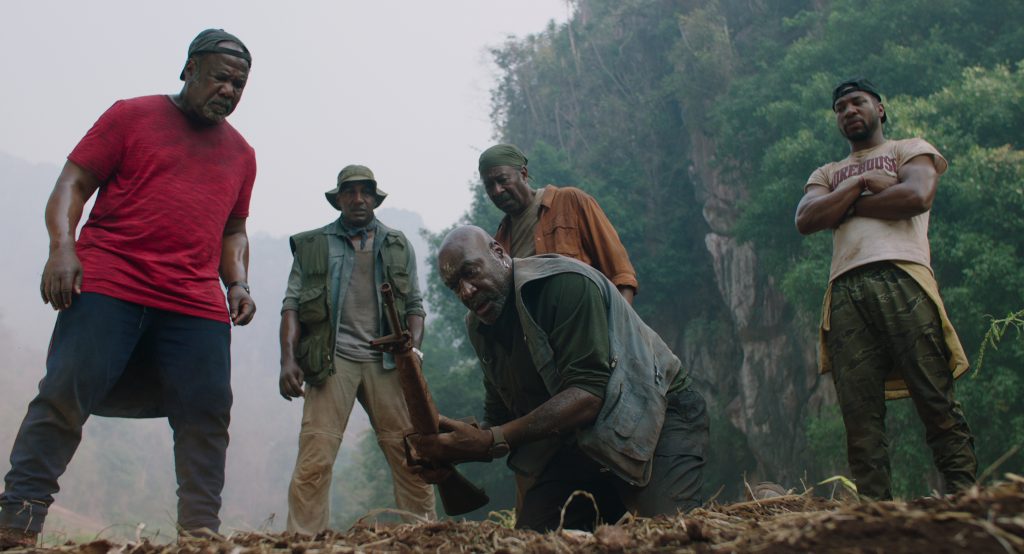August 2, 2023
by Carla Hay

Directed by Miles Joris-Peyrafitte
Culture Representation: Taking place in Albany, New York, in 2016, the dramatic film “To Good Mother” features a predominantly white cast of characters (with a few African Americans) representing the working-class and middle-class.
Culture Clash: An alcoholic journalist, whose adult son has been murdered, reluctantly teams up with her dead son’s pregnant girlfriend to find the killer, while the mother’s other son is a police officer whose department is also investigating the case.
Culture Audience: “The Good Mother” will appeal primarily to people who are fans of star Hilary Swank and procedural crime dramas, but this low-grade movie is often shallow and poorly staged.

“The Good Mother” had the potential to be a better mystery thriller than it is, but the movie is undone by scenes that are either monotonous or predictable, until it limps along to a very underwhelming ending. The big “plot reveal” is not surprising. “The Good Mother” also has a very generic and forgettable title (there are at least three other feature films with the same title) that is a reflection of this movie’s very generical and forgettable story.
Directed by Miles Joris-Peyrafitte (who co-wrote “The Good Mother” screenplay with Madison Harrison), “The Good Mother” was originally titled “Mother’s Milk.” In the movie (which takes place in Albany, New York, in 2016), Mother’s Milk is the nickname of a dangerous mix of heroin, cocaine and fentanyl that is being sold in the Albany area and has been killing several people in the area. The story involves a missing stash of Mother’s Milk, with the stash worth an estimated $50,000.
The beginning of “The Good Mother” shows a man in his 20s jogging on a residential street in the early morning daylight, right before he gets killed. Viewers later find out that this man’s name was Michael “Mike” Bennings (played by “The Good Mother” co-screenwriter Harrison), and he was a drug addict and a drug dealer. It’s also later revealed that Michael was shot in a drive-by shooting by someone driving a white truck. The shooter also has a large tattoo of a caduceus on one of his hands.
Michael’s widowed mother Marissa Bennings (played by Hilary Swank) is an alcoholic journalist who works for the Times Union, a newspaper for the Albany area. Marissa’s husband Frank died in 2013. The movie never bothers to mention how Frank died. On the morning that Marissa finds out that Michael was murdered, she wakes up from a drunken stupor and takes a swig from a liquor bottle near her bed.
Marissa has another son named Toby Bennings (played by Jack Reynor), who is a cop for the Albany Police Department. Toby is Michael’s older brother. Marissa gets the tragic news about Michael’s death when Toby suddenly shows up at Marissa’s job while she’s in a conference-room meeting with her co-workers.
Toby interrupts the meeting to say that he has to tell Marissa something important. What’s odd about this scene is that it isn’t revealed until a few scenes later that Toby is Marissa’s son. He approaches the meeting as if he’s a cop who knows Marissa on a professional level, not as a son telling his mother that her other son has been murdered.
At the graveside part of the funeral service, Marissa is angry to see Michael’s girlfriend Paige (played by Olivia Cooke) has shown up uninvited. Marissa walks over to Paige and punches Paige hard enough for Paige to fall down, just as Paige blurts out, “I’m pregnant.” Then, there’s an abrupt cut to the next scene of Marissa and Paige having coffee together at a diner. It’s one of many awkward transitions in this disappointing movie.
During this conversation, Marissa tells Paige that she’s sorry for punching her and says that she wouldn’t have hit her if she knew that Paige was pregnant. Paige, who is a recovering drug addict, comments to Marissa about Michael: “I didn’t make him a junkie.” Marissa replies bitterly, “You made him a thief.” Paige then says that she loved Michael.
Marissa knew that Michael was a drug addict, but she doesn’t know to what extent he was involved in drug dealing. Paige knows that Michael was involved in drug dealing with Michael’s friend Ducky (played by Hopper Penn), a disheveled drug addict who’s in the movie for only about 15 to 20 minutes. Almost nothing is revealed about Ducky or his personality except that he’s heavily involved in drugs.
Paige has told Marissa that Paige, Michael and Ducky had been planning to move to a farm together shortly before Michael was murdered. However, Paige is now estranged from Ducky, because Paige thinks that Ducky had something to do with Michael being murdered. Toby also believes that Ducky is a person of interest in this murder case. Ducky is a drifter who has become hard to find since Michael’s murder.
Paige is about to find out the hard way that some drug dealers are looking for $50,000 worth of Mother’s Milk that was last known to be in Michael’s possession. Shortly after Paige finds this stash hidden in the house where Michael used to live with her, some of these thugs break into her house at night when Paige is home alone. Paige is able to escape with the stash of Mother’s Milk.
And the first place she goes to is Marissa’s house, because Paige has nowhere else to go. Marissa reluctantly agrees to let Paige stay with her. Eventually, the two women decide that the police aren’t moving fast enough for the investigation into Michael’s murder. And so, Marissa and Paige decide to do their own sleuthing. Paige’s main way of “investigating” consists of posting inquiries on social media. Paige gets a lead in the case much more quickly than the police.
Meanwhile, Toby is not put on the case because his supervisors realistically know that Toby won’t be objective in this investigation. “The Good Mother” has an off-balance tone for Toby’s storyline, by putting a lot of emphasis on the fertility issues of Toby and his wife Gina (played by Dilone), who has been undergoing IVF (in vitro fertilization) treatments. At times, Toby seems more concerned about his wife getting pregnant than finding out who murdered his brother.
One of the biggest problems with “The Good Mother” is that there are so many missing parts to the story and so many gaps in logic, the movie quickly falls apart. For example, if these drug dealers are looking for Paige and the missing Mother’s Milk stash, one of the first places they would go to if Paige escaped from her house would be to the home of Michael’s next of kin. They probably wouldn’t go to Toby’s place, because Toby is a cop, but Marissa’s place would be the most logical place where Paige would try to hide.
During at least half of the story, Paige is openly living with Marissa. And yet somehow, the drug dealers looking for her don’t seem to find out this obvious information to find Paige at Marissa’s place. Paige is about seven or eight months pregnant, but she has action scenes that look unrealistic for someone in this late stage of pregnancy. In the scene where Paige escapes from her own house, she jumps out the house’s window and falls down hard on the ground, but she doesn’t even mention later how this fall could have injured her unborn child.
The movie makes it look like Paige is the only one investigating who could possibly know which criminal in the area has a large caduceus tattoo on a hand, even though in real life, police would most likely have that information on file. Another unrealistic thing about “The Good Mother” that’s never explained is why most people in this movie use outdated flip phones. In real life in 2016, most people with mobile phones were using smartphones. It’s as if “The Good Mother” director Joris-Peyrafitte wants to make 2016 look like 2006.
All of the characters in “The Good Mother” are written in superficial and trite ways. In a few private conversations that Marissa has with her understanding boss Jim (played by Norm Lewis), it’s mentioned that Marissa dislikes her co-workers and is an “old school” journalist who doesn’t like technology very much. Her boss and many other people in her life know that she’s an alcoholic, but no one really tries to get her professional help for this health problem. Marissa is also a chainsmoker who tries to quit smoking.
Jim tells Marissa that he thinks Marissa is the newspaper’s most talented writer but she hasn’t written anything in a while. Marissa took a three-month leave of absence after her husband died three years ago. But now, soon after the death of her younger son, Marissa wants to be back on the job. Jim thinks she should take some time off to grieve.
Toby is described as the “good son” and Michael as the “bad son.” But beyond a few quick flashbacks of their childhoods in home videos, there is nothing in “The Good Mother” that gives meaningful backstories about Toby and Michael. The relationship between Michael and Paige is also vague. All viewers know is that Michael and Paige had a drug fueled-relationship, but she stopped using drugs around the time of her pregnancy.
There were several people at Michael’s funeral, but then they are nowhere to be seen during the rest of the movie. Observant viewers will notice that Marissa, Paige, Toby and Gina don’t seem to have any friends or other relatives in their lives. No one checks in on them after the funeral to help them cope with their grief. Who were those people at the funeral? It’s a question that the movie never bothers to answer.
The sleuthing done by Marissa and Paige often looks phony. For someone who’s supposed to be an experienced journalist, Marissa doesn’t do much investigating. Marissa lets Paige do a lot of the real work. Paige has a very blunt and impatient style of interrogation, so there are some scenes of Marissa and Paige clashing with each other because Marissa doesn’t really like Paige’s personality. However, Paige is the one who actually gets results in their investigation.
“The Good Mother” is really just a lazy recycling of every Lifetime TV-movie about mothers seeking justice for their murdered children. But there are Lifetime TV-movies with more depth than “The Good Mother.” The acting talent in “The Good Mother” is better than in most Lifetime TV-movies, but that talent is underused in a very substandard screenplay that doesn’t care to show the main characters in a well-rounded way.
Swank has played many prickly characters before, while Cooke (who is British in real life) tends to portray a lot of working-class American characters who are rough around the edges. There’s nothing new or groundbreaking about their performances. The rest of the characters in “The Good Mother” are as generic as generic can be. No one is doing anything special in this hackneyed movie.
The trailer for “The Good Mother” is somewhat misleading, because Marissa and Paige teaming up for their investigation doesn’t get as much screen time in the actual movie as the trailer might lead viewers to believe. Worst of all, “The Good Mother” hastily throws in a plot development about something that “cures” Marissa’s writer’s block, which then leads her to make a life-changing decision where the aftermath is never shown. If “The Good Mother” had bothered to show the Bennings family as something other than stereotypes, then maybe viewers would care more about what happens to this dysfunctional family.
Vertical released “The Good Mother” in U.S. cinemas on September 1, 2023.


